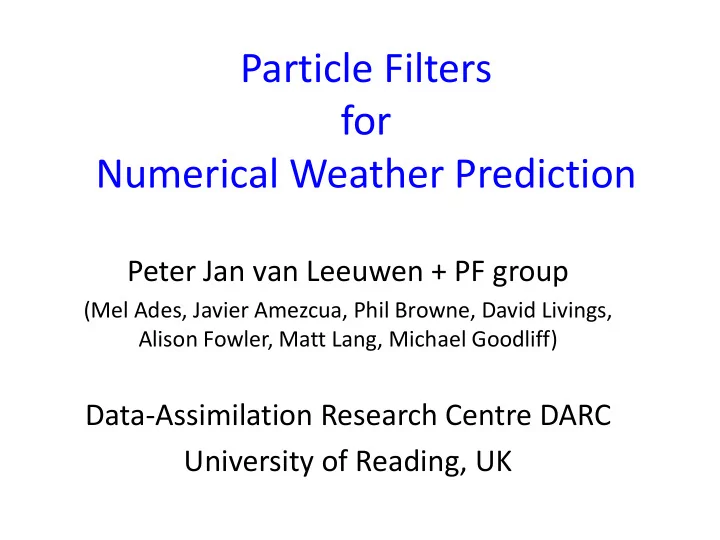

Particle Filters for Numerical Weather Prediction Peter Jan van Leeuwen + PF group (Mel Ades, Javier Amezcua, Phil Browne, David Livings, Alison Fowler, Matt Lang, Michael Goodliff) Data-Assimilation Research Centre DARC University of Reading, UK
What is a particle filter? • Write the prior pdf as • Then the posterior pdf is given as with the weights w i related to the distance to the observations and the model equations
Curse of dimensionality The weights are degenerate with a large number of observations: one particle gets weight 1, rest weight 0. This problem has largely been solved: - Particle filters have enormous freedom via proposal density: - Relaxation to observations between observation times - E.g. Equivalent-Weights Particle Filter is not degenerate by construction - ONLY APPROXIMATION IS FINITE ENSEMBLE SIZE - Example: 65,000 dimensional highly nonlinear barotropic vorticity model, observations every 50 timesteps, 32 particles
Equivalent-Weights Particle Filter • Force model towards observations between observation times • Ensure that weights are equivalent at observation times: y y t=0 t=50 t=100
Fully observed system
Half-observed system Observe 1/16 of the grid points within the red square only.
The relaxation step b=0.05 b=0.4
The Equivalent-weights step
Convergence of the pdf 32 particles 128 particles 512 particles
Rank histograms Full state observed
Between observations • Relaxation (nudging) • 4DVar on each particle: Initial condition fixed Model error essential X X X X
Why Particle Filters? • PF solve fully nonlinear data-assimilation problem • No state covariances !!! 4DVar: B matrix, EnKF’s localisation+inflation • Model errors essential, so we have to work on them: natural way to model improvement • Particles are independent random draws from posterior pdf • Perfect for forecasting!
Conclusions + Outlook • Particle filters do not need state covariances. • Proposal density allows enormous freedom • We can solve the curse-of-dimensionality problem by construction, e.g. Equivalent-weights scheme • Other efficient schemes are being derived. • We have to work on model error covariances • We are working on applications to ECMWF system and HadCM3 climate model
¼ observations over half of state
Recommend
More recommend